Jalapeño Cheddar Focaccia
Made for spice enthusiasts and cheese lovers alike.
Jalapeño Cheddar Focaccia. The name alone puts my salivary glands to work! Think jalapeño popper but in bread form. Made for spice enthusiasts and cheese lovers alike. It’s an irresistible fusion of heat from jalapeño peppers and savory notes of cheddar cheese. Even if you’re a novice bread maker, any of my focaccia recipes are the perfect place to start.
Table of Contents
Ingredient notes.
Flour
When making bread, I prefer to use bread flour due to it’s high protein content and structure. Read more about the different types of flour here.
Water
Filtered water is best. This is because tap water may contain impurities like chlorine or minerals that could affect yeast activity and overall quality of the bread. To ensure a clean and consistent environment for the yeast to thrive, use filtered water.
Salt
I rarely ever use table salt in my recipes. When you see salt, think sea salt. Table salt often contains additives and anti-caking agents, which affects quality of your baked goods. Table salt is also saltier and is not an equal substitute for other salts.
Sugar
Sugar provides food for the yeast during fermentation. It helps with the leavening process and promotes a better rise. It also helps with structure, color and the final flavor of my focaccia.
Yeast
This recipe uses instant yeast but you may use active dry yeast instead. See my notes in the recipe for special instructions. Read more about the different types of yeast here.
Cheddar Cheese
Cheddar is sharp, rich in flavor and the most iconic cheese paired with jalapeño. But most importantly, please freshly shred your cheese! There is a sneaky ingredient hiding in pre-shredded cheeses known for it’s anti-caking and moisture absorbing properties. Pre-shredded cheeses just don’t melt right. Trust me.
Jalapeños
Pickled jalapeños are convenient and offer a tangy and slightly milder flavor. The process of pickling tones down the heat, making them more palatable for a broader range of taste preferences.
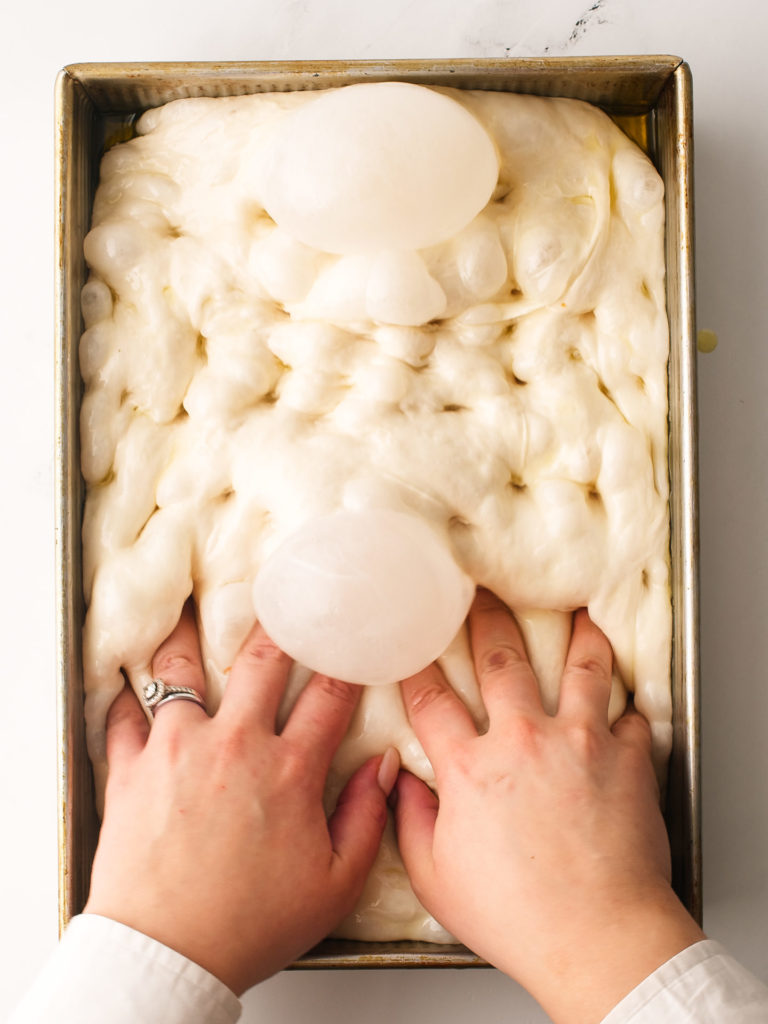
Sample Schedule for making Jalapeño Cheddar Focaccia.
Like many other bread recipes, this focaccia requires two phases of rising. Below are two sample schedules for making my focaccia. Both convenient even for the busiest of schedules.
Refrigerator first rise, room temperature second rise.
This is my preferred method. I like to call this one the express bubble rise because its fast and yields big bubbles. Once you’ve completed the stretch and folds, coat the bowl and surface of the dough with olive oil, cover with plastic wrap, place in the refrigerator and forget about it, for as little as 4 hours to as long as 12 hours but no longer than that. Then, after this first rise in the refrigerator, transfer to a generously oiled, non-stick baking tray and let it rise at room temperature for anywhere between 1 to 2 hours until the dough no longer feels cold and springs back when you press on it.
Room temperature first rise, room temperature second rise.
If you’ve been following along, this is first sample schedule I introduced everyone to when I first shared my focaccia recipe. Once you’ve completed the stretch and folds, cover the bowl with plastic wrap and tea towel and leave it in a warm spot to proof for 1 to 1½ hours. The ideal temperature for bread to rise is between 74°F to 85°F / 23°C to 29°C.
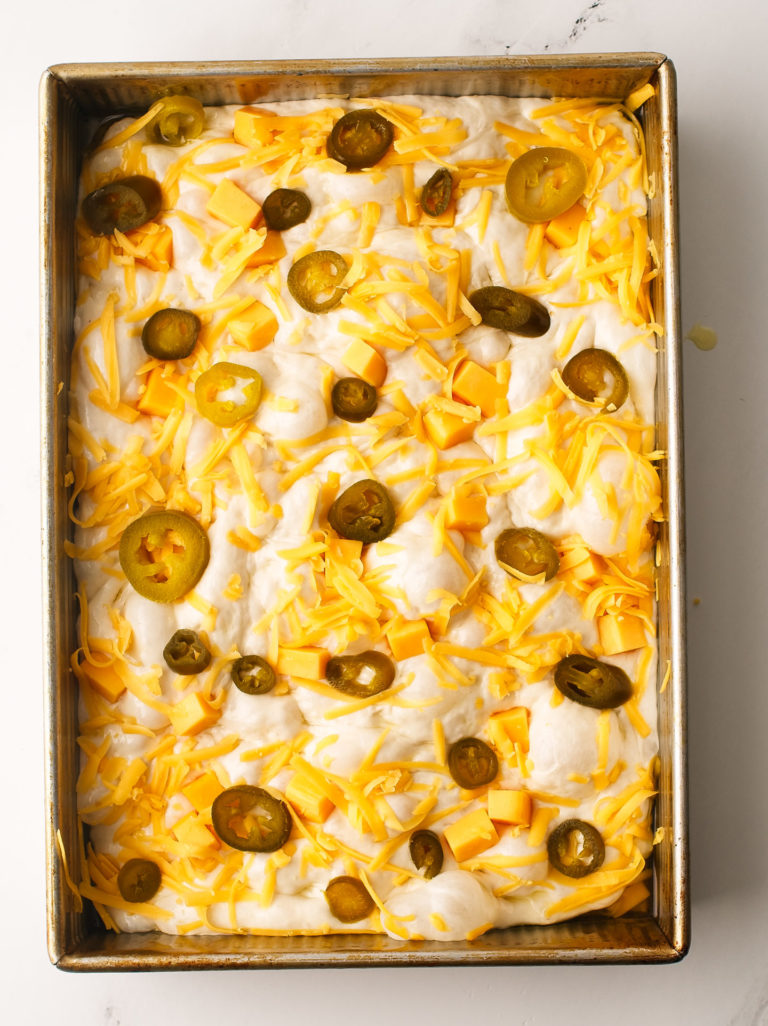
Measure flour the right way.
Understanding the importance of measuring flour by weight rather than volume is crucial for achieving accurate results in baking. Unlike other ingredients, flour can significantly change the overall structure, texture and quality of your baked goods, especially bread. This introduction sets the stage for why weight matters when working with flour.
Best practice for measuring flour with/without a scale
Read all about my expert tips in my blog post How to Measure Flour. My number one tip is get a scale. It takes away the guessing game and gives you consistent results every single time. Shop my exact kitchen scale for baking here. (Affiliate link)
Expert tips for making Focaccia.
Be generous with the olive oil
Focaccia is renowned for its olive oil infused crust. Be generous when drizzling olive oil on top of the dough and on the bottom of the baking pan. It also helps you achieve the signature crispy exterior.
Slow rise for flavor
Don’t rush the process. Allow the dough to undergo a slow fermentation for enhanced flavor. Fermentation is a fancy word for the rising phases in bread making. I created two sample schedules for this process. See above.
Proper stretch and folds
This process helps develop gluten, resulting in a light and airy structure. Especially for a novice baker, working with dough can be intimidating but focaccia is the best place to start. You’re in the right place! Watch my video tutorial for extra help.
Two types of stretches.
Stretch and fold method
The recipe recently adapted two types of stretches. This is the first type of stretch. First, wet your hands before proceeding as it will make it easier to handle the dough. Work your way around the dough like you are looking at clock. Perform a fold at 12, 3, 6 and 9 o’clock by pulling the dough up and over to the other side of the bowl. Cover with a tea towel for 10 minutes.
Coil method
This is the second type of stretch. Wet your hands again. Gently loosen the edges of the dough by pulling it away from the sides of the bowl. Place your fingertips under the dough, so that you can pick it up in the middle. Allow the dough to unstick from the bowl and fold using its own weight, while you support the middle. Turn the bowl 90° and repeat to perform another coil fold.
Do this method 3 more times, roughly 10 minutes apart. With each set of folds, the dough gluten structure gets stronger, making it easier to lift and fold. Because this method was recently adapted to the recipe, see the full coil method shown in my Everything Bagel Focaccia recipe video.
Frequently Asked Questions about Focaccia.
What is the best pan to use for focaccia?
I suggest an aluminum, non-stick pan. Glass is a very poor conductor of heat and I don’t recommend it. Having the right baking tools makes all the difference in your recipes. Linked below is the exact baking pan I use for all my focaccia recipes. Shop my exact 9″x13″ Baking Pan here (Affiliate link)
Can I use active dry yeast instead of instant yeast to make focaccia?
You can substitute one for the other at a 1:1 ratio but keep in mind, active dry yeast needs to be activated first. First, measure 240ml or 1 cup of the warm water from the recipe in a wide mouth cup or bowl. Add in a teaspoon of sugar and sprinkle the yeast on top. Whisk together to combine and let it sit for 5-10 minutes until foamy and bubbly on top. Then, add to the dry ingredients, along with the remainder of the water and proceed with baking directions. For extended instructions, see Active Dry Yeast vs. Instant Dry Yeast blog post.
Why does my focaccia have fewer bubbles than yours?
Bubbles are a sign that the yeast is doing it’s job. Yeast releases gases, carbon dioxide to be exact, and that produces the holes you see in bread. In order for yeast to work, it needs to eat and that’s where sugar and water come in. Unlike other recipes, this one calls for lukewarm water.
If you don’t notice foaming or bubbles, the water was either too hot and killed the yeast or the yeast is expired. This recipe calls for lukewarm water but for reference, try to stay between 100°F-110°F (36°C-40°C).
Why is my focaccia so sticky?
If the dough is sticky, you’re doing something right. Focaccia is a high hydration dough, meaning it has a higher water to flour content than an artisan bread, for example. The oil is what helps make this dough manageable. I use my Danish dough hook for just about every no-knead bread recipe. It s unique design helps incorporate ingredients efficiently, develop gluten for better texture and structure in the bread without overworking the dough. Shop my exact Danish dough hook whisk here (Affiliate link) This one comes with additional bread making tools, perfect for novice bakers to try my Easy, No-Knead Artisan Bread.
How to store leftovers.
Focaccia is best enjoyed same day. Store leftovers at room temperature, wrapped completely in plastic wrap and a tea towel, up to two days. This method of wrapping helps retain moisture and keeps it fresh and soft. It does take away the crusty skin of bread but you are left with a soft, edible bread, instead of a hard, dry loaf. It makes amazing sandwiches the next day. If your focaccia has toppings like cheeses and meats, please consume same day. It should never be stored in the refrigerator.
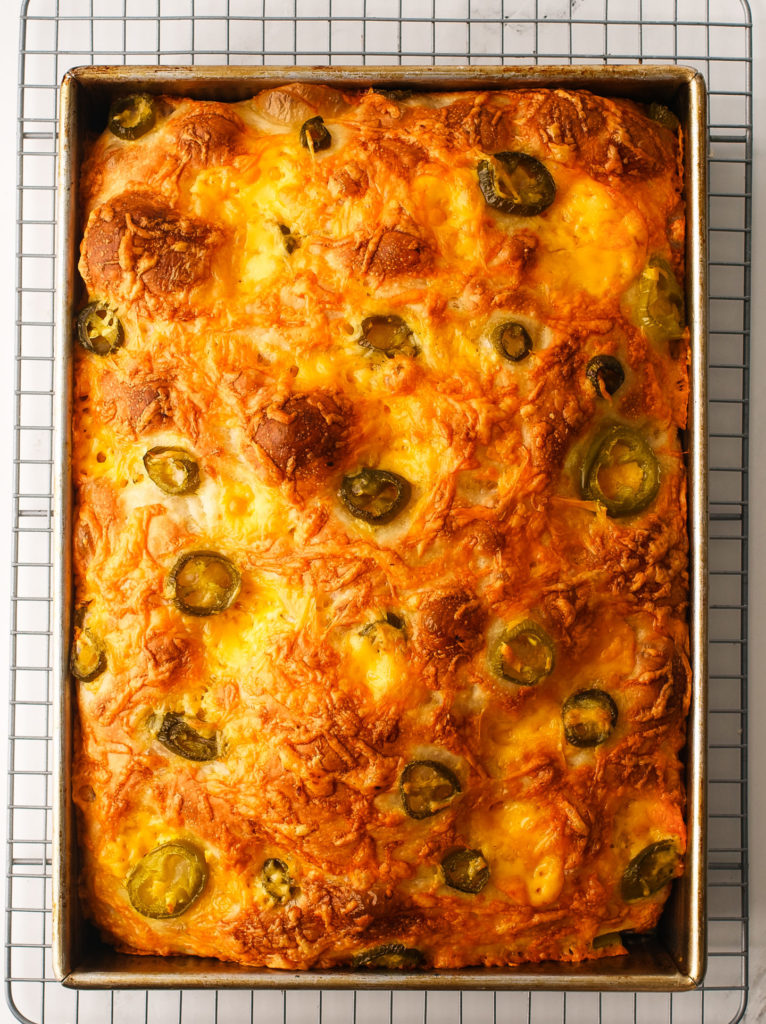
Looking for other focaccia recipes?
Before you go, take a look at my other popular focaccia variations here:
Your feedback is valuable to us. If you have any questions, please let me know in the comments. If you try my recipes and love them, please take a moment to leave a five star review. Thank you for being part of the Bake Cook Repeat community! Don’t forget to follow us on Facebook, Instagram, Pinterest and Subscribe on YouTube.
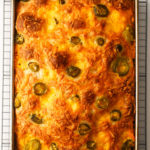
Jalapeno Cheddar Focaccia
Patricia Martinescu from Bake Cook RepeatIngredients
- 500 ml warm water
- 1 Tablespoon sea salt
- 1 Tablespoon granulated white sugar
- 2 teaspoon instant yeast see note below if using active dry yeast
- 1 Tablespoon olive oil
- 550 g bread flour
For the toppings:
- 1/4 cup Jalapeño pickled or fresh
- 1 cup cheddar cheese grated and cut into 1/2” cubes
Instructions
- Read my expert tips, FAQ and watch the video tutorial before beginning.
- To a large mixing bowl, add all the ingredients in order as listed except the flour. Whisk together, then add the flour. Use a Danish dough hook or the neck of a wooden spoon to mix for at least 1 minute until the dough is wet and sticky. This is the most work you'll do for this recipe. Then, cover with a tea towel and allow the dough to rest for 10 minutes.500 ml warm water, 1 Tablespoon sea salt, 1 Tablespoon granulated white sugar, 2 teaspoon instant yeast, 1 Tablespoon olive oil, 550 g bread flour
- For this recipe, I have recently adapted two types of stretches.STRETCH AND FOLD METHOD: This is the first type of stretch. First, wet your hands before proceeding as it will make it easier to handle the dough. Work your way around the dough like you are looking at clock. Perform a fold at 12, 3, 6 and 9 o’clock by pulling the dough up and over to the other side of the bowl. Cover with a tea towel for 10 minutes.
- COIL METHOD: This is the second type of stretch. Wet your hands again. Gently loosen the edges of the dough by pulling it away from the sides of the bowl. Place your fingertips under the dough, so that you can pick it up in the middle. Allow the dough to unstick from the bowl and fold using its own weight, while you support the middle. Turn the bowl 90° and repeat to perform another coil fold. Do this method 3 more times, 10 minutes apart. With each set of folds, the dough gluten structure gets stronger, making it easier to lift and fold. Because this method was recently adapted to the recipe, see the full coil method shown in my "Everything Bagel Focaccia" recipe video.
- Coat the entire focaccia and bowl with oil, about 3 Tablespoons. Cover the bowl with plastic wrap and a tea towel. Let it rise in a warm spot at room temperature for at least 1 to 1 ½ hours or in the refrigerator for 4 to 12 hours. I prefer the longer, refrigeration rise. This yields the biggest bubbles and most flavor. Read more about my alternative rising schedules in this blog post.
- Remove the plastic wrap. Move the bowl back and forth, opening up the bubbles and allowing the dough to breathe. Coat a generous layer of olive oil on the bottom of a 9"x13" inch aluminum, non-stick baking pan. For good measure, you may also line the bottom with parchment paper prior to drizzling the oil.
- Pour the dough into the pan. The dough may seem to "deflate" but don't fret. Fold the dough into thirds, rotate 90 degrees so that the dough is in line with the pan and flip over, revealing the smoother side on top. Gently spread the dough into the corners with your fingertips but don't force it.
- Cover with plastic wrap and place in a warm spot at room temperature for at least 1 hour. The dough will continue to stretch and rise into the corners in this final proof. Please note, if you followed the refrigeration sample schedule, you need to let the dough come to room temperature and this may take up to two hours max.
- Preheat the oven to 450°F / 232°C.
- When the oven is done pre-heating, remove the plastic wrap and lightly drizzle the top of the dough with olive oil.
- Coat your fingertips with some of the oil. This helps prevent sticking as you make your dimples. To do that, use your fingertips to press into the dough, creating soft indentations and bubbles on the entire surface. The dough should slowly spring back. We are looking for jiggly dough. Evenly coat the surface with cheddar cheese and pickled jalapeños. If using fresh, be mindful to remove the seeds. Most of the heat comes from them.1/4 cup Jalapeño, 1 cup cheddar cheese
- Place into the oven for 22-24 minutes until golden brown and crispy. Depending on the strength of your oven, baking time may vary by a few minutes.
- Transfer to a wire rack to cool before slicing.
Notes
- The ideal temperature for bread to rise is between 74°F to 85°F / 23°C to 29°C. If your room feels drafty, place the bowl covered with a tea towel in the oven, with door closed and turned off. If it hasn’t doubled in size and bubbled up in the rise time, perform a set of folds, and let it sit for an additional 20 minutes.
- I highly recommend to weigh your dry and wet ingredients for best accuracy. If you don't have scale, please measure liquids at eye level and flour with the fluff, spoon and level method. Measuring flour the accurate way is important for baking recipes. See How to Measure Flour blog post for more information.
- You may substitute instant yeast with active dry yeast at a 1:1 ratio but keep in mind, active dry yeast needs to be activated first. If using active dry yeast, first measure 240ml or 1 cup of the warm water from the recipe in a wide mouth cup or bowl. Add in a teaspoon of sugar and sprinkle the yeast on top. Whisk together to combine and let it sit for 5-10 minutes until foamy and bubbly on top. Then, add to the dry ingredients, along with the remainder of the water and proceed with baking directions. For extended instructions, see Active Dry Yeast vs. Instant Dry Yeast blog post.
- Focaccia is best enjoyed same day. Store leftovers at room temperature, wrapped completely in plastic wrap and a tea towel, up to two days. This method of wrapping helps retain moisture and keeps it fresh and soft. It does take away the crusty skin of bread but you are left with soft, edible bread, instead of a hard, dry loaf. Focaccia is perfect for sandwiches the next day.
Nutrition
The provided nutritional value above is an estimate per serving. 100% accuracy is not guarenteed. Please see Nutrition Information Disclaimer in our Privacy Policy.
Nutrition Information Disclaimer8 Comments
-
-
-
 Hillary LaMay
Hillary LaMay
My family went bonkers for this recipe! It was so easy, and Patricia does something that I wish all bloggers would do- she includes the measurements in line with each step, so when you’ve got dough hands, you don’t need to flip back to the list of ingredients for the measures. I feel like I’m listening to a friend guide when I follow her recipes, and they are so approachable and simple. Thanks for everything you do!-
 Patricia
PatriciaThank you for noticing and appreciating those extra steps I take to make sure anyone who tries my recipes is successful! You’re the best! 🙂
-
-
 Manuela
Manuela
I have a house full of jalapeño lovers, and this bread just topped everything! honestly beyond amazing. this recipe is the best thank you!-
 Patricia
PatriciaHi Manuela, thank you! I’m so glad you enjoyed my focaccia recipe! I have 2 other versions for you to try as well. 🙂
-
-
 Diana
Diana
Thank You for sharing your recipe. I tried lots of focaccia bread, but none of them was tastier and stayed fresh for the next day like yours. My kids loved it. I can call it “The best focaccia bread “, I ever had. -

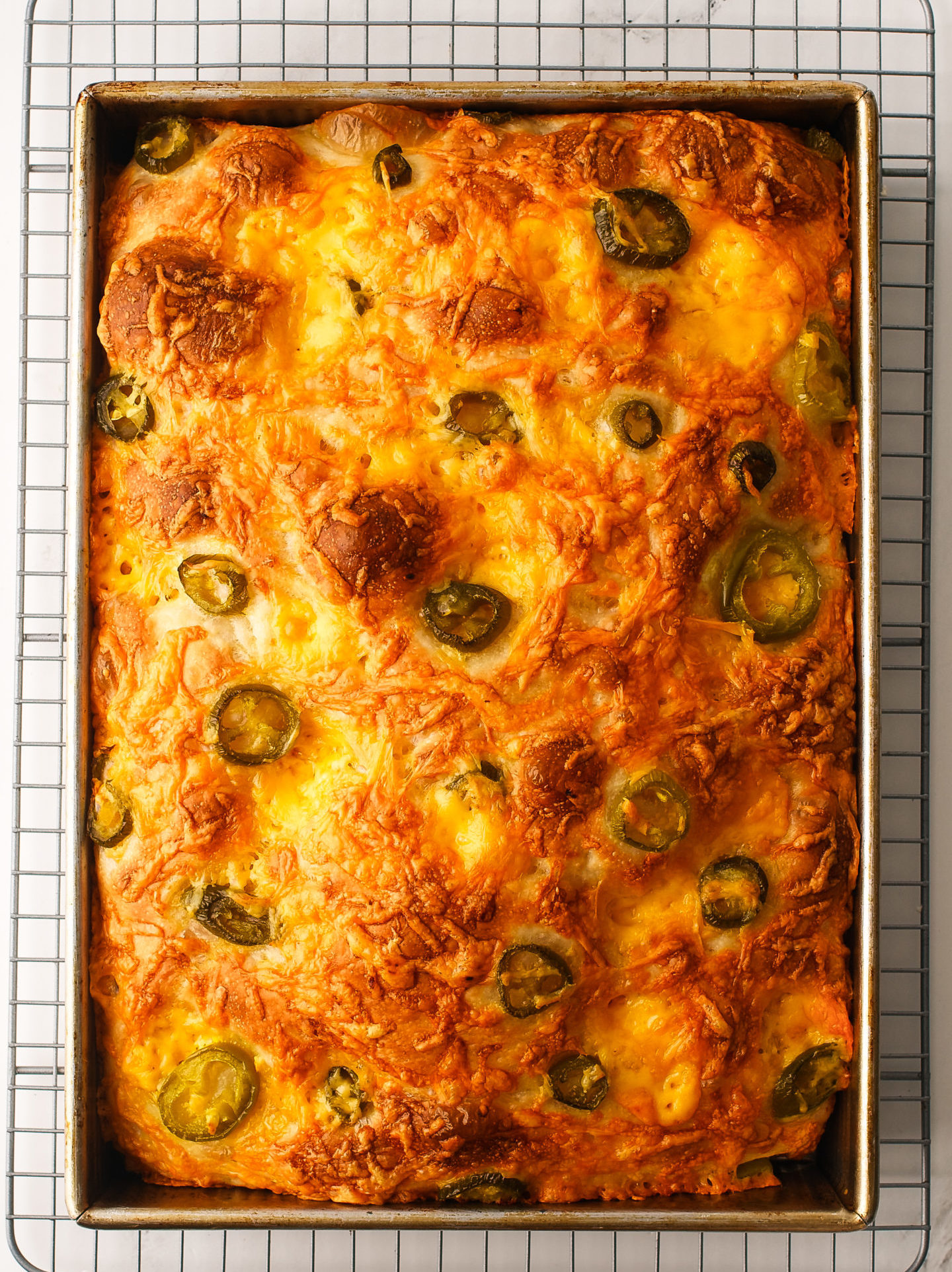
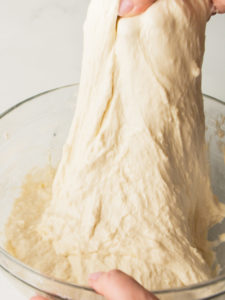


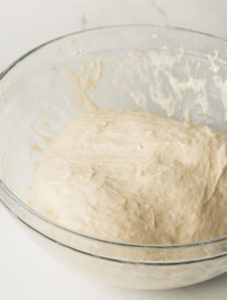
I made this focaccia for my coworkers and it was a BIG hit! Very easy to follow and I love the step by step photos